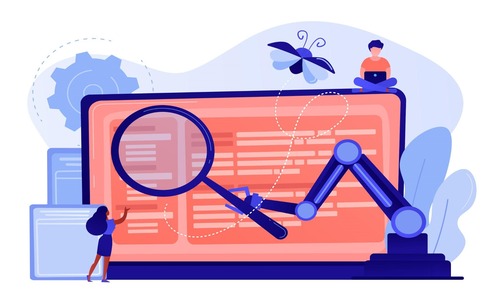AI search algorithms are changing the rules of SEO. And if you’re not keeping up with the new trends, your brand can easily fall behind the competition.
Recent research from Bain & Company reveals that 80% of people rely on AI-driven search results for at least 40% of their searches, leading to a 15% to 25% drop in organic traffic.
How can you adapt to ensure your brand remains visible to this growing audience?
The answer lies in investing in AI search engine optimization. This article breaks it down and provides practical steps to help you stay visible in 2025 and beyond.
What Are AI Search Algorithms?
AI search algorithms are advanced methods designed to understand natural language queries and deliver relevant results from indexed data. Unlike traditional SEO, these algorithms analyze the context and intent behind a user’s search to provide content that closely matches what they’re actually looking for.
For example, if you search for “what to look for in best phones for photography” on Google, the AI doesn’t just match the exact words. Instead, it understands that you’re interested in smartphones with high-quality camera performance. It then surfaces relevant product reviews, compares specifications, and links to expert advice and curated lists of top camera phones, even if those pages don’t include the exact search phrase.

How AI Search Algorithms are Shaping SEO?
AI algorithms have changed how search engines evaluate and rank content. Traditional factors like keyword density and link-building remain important, but they’re no longer the only elements that influence a brand’s online visibility. Today, the success of SEO content hinges on how well your content aligns with user intent and context, as understood by advanced AI systems.
AI algorithms use machine learning, natural language processing (NLP), and data analytics to better understand what users type and what they mean. As a result, SEO is no longer about optimizing just for search engines but about creating experiences that genuinely serve human needs.
Here are a few ways AI is transforming SEO.
- It’s All About Intent. Search engines are no longer just matching keywords. They’re trying to figure out why someone is searching. That means your content needs to answer the real question behind the search, even if it doesn’t use the exact words.
- Context is King. AI looks at the whole picture, including your location, what you’ve searched before, and even the time of day. So, content that’s contextually relevant and useful in the moment will always perform better than something that’s just stuffed with keywords.
- Entity Recognition. Instead of focusing on individual keywords, AI now identifies entities like people, brands, and places and how they connect. This shift is at the core of an AI search visibility entity-first strategy, where content that naturally includes these entities and uses structured data helps search engines understand how everything fits together.
- AI Search Voice Search. Search engines are getting smarter at understanding images and voice commands. This means you’ll want to optimize for alt text, use schema markup, and write in a way that sounds natural as if talking to an audience.
- Personalization is Key. AI tools like ChatGPT can tailor to AI search user behavior and preferences. So, the more personalized and engaging your content is to a specific audience, the better it will perform.
AI Search Engine Optimization: The Solution to Staying Visible in 2025
AI search engine optimization, or Generative Engine Optimization (GEO), is the process of creating content optimized for AI-powered search engines and tools. These include Google’s Search Generative Experience (SGE) or AI assistants like ChatGPT, Perplexity, and Gemini.
Traditional SEO has for long focused on keyword density, backlinks, content relevance, and building the brand’s authority. The goal? Get more clicks, more traffic, and more conversions.
However, a study by Bain & Company shows that 60% of searches end without the user clicking on any website, thanks to Google’s AI Overviews.
That’s why GEO offers a different approach. Instead of just aiming for clicks, it focuses on writing structured, conversational content that clearly answers questions and has a high potential to rank for generative search results.
AI search optimization focuses on:
- Optimizing content for user intent, not just keywords
- Creating clear and structured content for AI understanding and parsing
- Writing in natural language and conversational tone
- Including semantically related terms and entities
- Implementing structured data and schema markup
- Enhancing content with multimedia elements
- Focusing on topical authority and content depth
- Maintaining content freshness and regular updates
Techniques and Best Practices for AI Search Optimization
Now that you know what AI search engine optimization is, let’s talk about how to make it work. Here are the seven best practices to create content that aligns with AI search algorithms and helps your brand stay in the game.
1. Understand Search Intent
Search intent is the true goal behind the search query or the solution users seek through their searches. Understanding search intent sets the very foundation for GEO. It guides your content creation to resonate with the user and provide a relevant solution to their problem.
Consider these questions to understand the primary intent behind a query.
- Is the query informational, navigational, or transactional?
- Is the query a question, a command, or a product name?
- What types of results does Google show?
- What kind of content is currently ranking?
- What exact questions are people asking on online forums or social media?
Once you have your answers, they will inform your content creation through valuable information and the most relevant keywords.
2. Identify Relevant Keywords
Unlike traditional SEO, AI tools are designed to deliver personalized and more nuanced solutions to user problems instead of just matching keywords. However, all online searches start with a keyword. Therefore, you still need to identify and incorporate keywords that your target audience uses in its queries.
While keyword research for both SEO and GEO is the same, consider these factors for AI search optimization:
- Identify semantic keywords instead of exact matches
- Target long-tail keywords and natural language searches
- Find keywords that align with your search intent.
- Create keyword and topic clusters.
With keyword research covered, you’re ready to create content that will rank for generative search engines.
3. Meet Google’s E-E-A-T Standards
EEAT are the guidelines set by Google to ensure that content published online is high quality and written with proper expertise and knowledge of the user’s intent. It is based on Google’s mindset for creating helpful and people-first content so that users get what they expect from your website.
EEAT stands for:
- Experience: Real-world or first-hand experience of the author on the topic. It aims to deliver authentic and unique content sourced from an experienced person in the field instead of an AI tool.
- Expertise: Comprehensive and research-backed content that shows the author’s command over the topic. Google Quality Raters also examine the author’s profile and qualifications to measure expertise.
- Authoritativeness: How much authority a website or content creator holds and whether users prefer your website for retrieving specific information. You can build authority through backlinks, a strong online presence of authors, and content covering all perspectives of a topic.
- Trustworthiness: How accurate and factual is the information in your content? To establish trust, your website should have an honest intent. Your content should be aligned with the latest trends. Plus, positive testimonials and reviews should support your services.
4. Content Structure and Clarity
AI tools thrive on well-structured and clearly organized content. This means using headings, subheadings, and lists to create a logical flow that’s easy to follow.
Why is this important?
A clear content structure makes it easier for AI tools to navigate and extract relevant information. When content is cluttered with long paragraphs or lacks subheadings, AI crawlers may struggle to determine whether it meets the user’s needs.
Here’s how to create well-organized content.
- Use Descriptive Headings: Include detailed headings and subheadings that clearly outline the context of each section. This helps AI determine whether a particular part of the content is relevant to the user’s query.
- Create Short Paragraphs: If dividing content into headings or subheadings isn’t feasible, break bulky content into shorter paragraphs. This makes it easy for both readers and AI to process the information.
- Make Bullets and Tables: Transform long blocks of text into concise bullet points or tables. These formats are easier to scan and help highlight key information.
- Add Image Alt Text: Provide descriptive alt text for images so that search engines and AI tools can understand their relevance in context.
5. Incorporate Multimedia Content
AI search models do not just analyze text but also multimedia types such as images, videos, and infographics. These elements help the AI tools understand whether your content is valuable and aligned with the AI search context.
Why does this matter? If your articles don’t have multimedia elements, you’ll miss out on the opportunity to engage AI tools from multiple platforms and attract users to your site.
In fact, MarketingAid.io conducted a study using 500 AI searches, showing that almost all the articles cited by AI tools had images. General queries showed images about 70% of the time, while YMYL (Your Money or Your Life) queries cited images about 10% of the time. Similarly, videos were shown in 90% of general queries, with nearly half displaying at least one video.
6. Diversify your Content Strategy
Apart from utilizing diverse forms of multimedia, another way to optimize for AI search intent is to distribute content across multiple platforms.
What does this do? AI tools parse content from various platforms, such as online forums, social media, ebooks, podcasts, and more. Creating content for these channels not only engages a broader audience but also creates more opportunities for AI to index content.
Here’s how to adopt an AI search multichannel strategy.
- Repurpose content for distribution across diverse channels.
- Tailor content type to the unique features of each platform.
- Understand the specific needs and preferences of each channel’s audience.
- Post snippets or summaries of content consistently on social platforms.
7. Create Authoritative Content
To rank well in AI-driven searches, your content needs to be authoritative and based on facts. Google takes this as a key indicator that the content you publish is human-written and reliable. You can add authority using citations, link to reputable sources, and include data, statistics, or expert quotes.
Why does this matter for AI search engines?
In the words of Neil Patel himself:
“If you’re an authoritative voice, then your content is likely to be linked to from other domains. You’re also more likely to be included in industry roundups. This signals to search engines and answer engines that your content is valuable, which makes it more likely to be featured.”
8. Technical Tips for AI Search Optimization
Content may be the king, but technical SEO is just as important. If your website is not optimized for technical health, even the best pieces of content can get lost in the competition.
How is this relevant to AI searches? AI tools are designed to deliver high-quality, fast responses to user queries. Technical SEO ensures your website is optimized for this so that AI tools can crawl and index your content efficiently.
To optimize for technical SEO:
- Improve Crawlability: AI tools must crawl your website to index relevant content. Use a clean structure with a precise sequence of pages and links to enhance your website’s crawlability. You can also add internal links or an XML sitemap to help AI bots go from one page to another easily.
- Add Structured Data: Use schema markup to structure your data. It tells search engines exactly what your content is about, whether a product, FAQ, steps, pricing, or ratings. Why does this matter for AI SEO? Because it gives AI specific cues about the context of the content, helping it appear in search results.
9. Adapt to AI Search Trends
AI search algorithms are evolving rapidly. If you want your brand to stay visible, it’s essential to adapt to new trends proactively. Here’s what you can do to stay aligned with AI search trends.
- Stay Up-to-date: Regularly follow updates from search engines and industry experts to stay informed about the new changes in AI algorithms and GEO strategies.
- Perform Regular Content Audits: Update your content regularly to keep it aligned with current AI trends. Expand the existing content with more depth, monitor for content decay, and refresh it to keep it relevant.
- Implement A/B Testing: Experiment with different content formats to see which ranks well in AI searches. A/B test using AI search analytics monitoring tools to identify the most effective approaches and refine your content strategy.
Final Words
AI-driven search is reshaping traditional SEO. It offers brands the opportunity to reach a broader audience across platforms like Google SGE, ChatGPT, Perplexity, and others. To stay visible in this new era of search, optimizing for AI search algorithms is essential. Now is the time to explore how your brand can adapt and thrive in this evolving search landscape.





